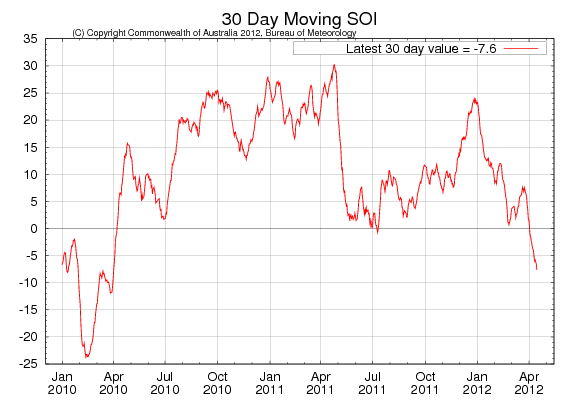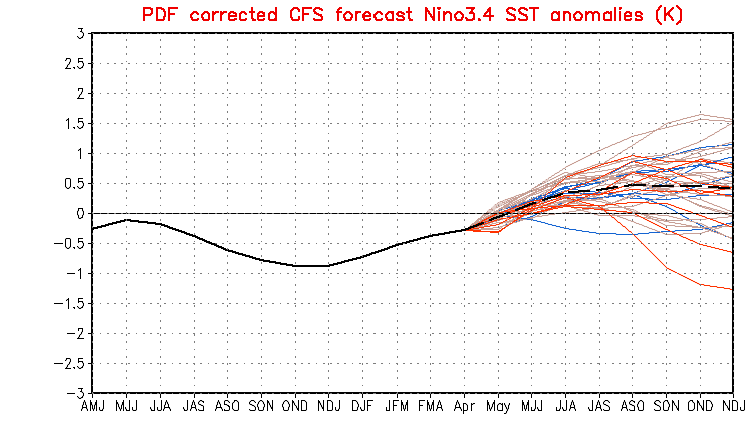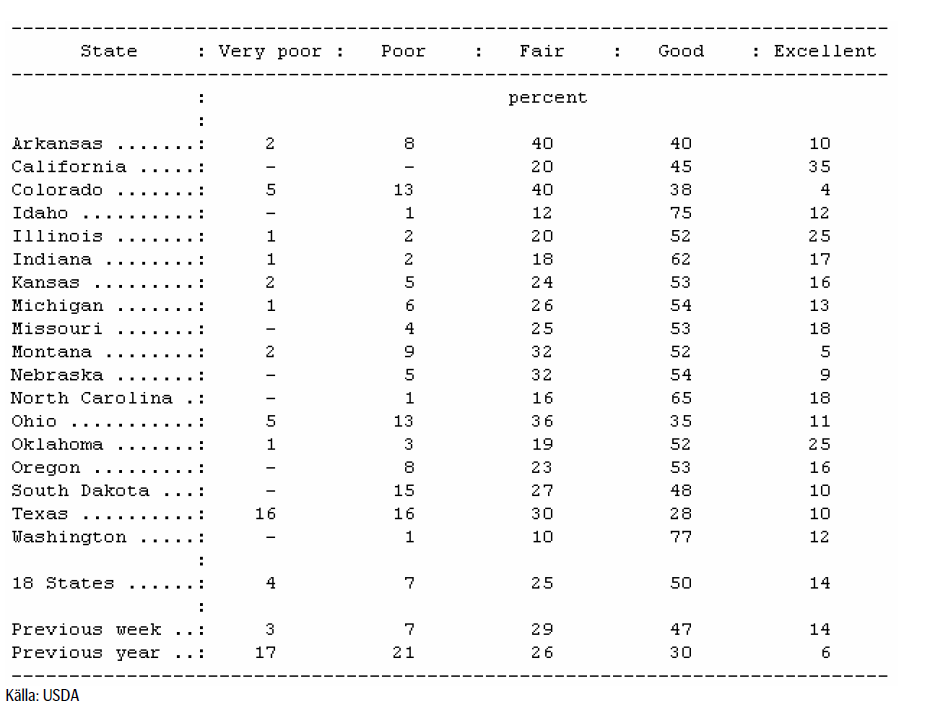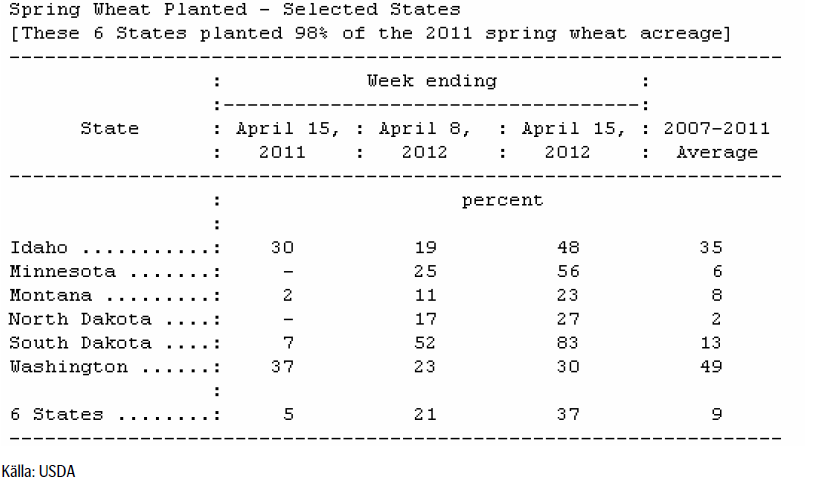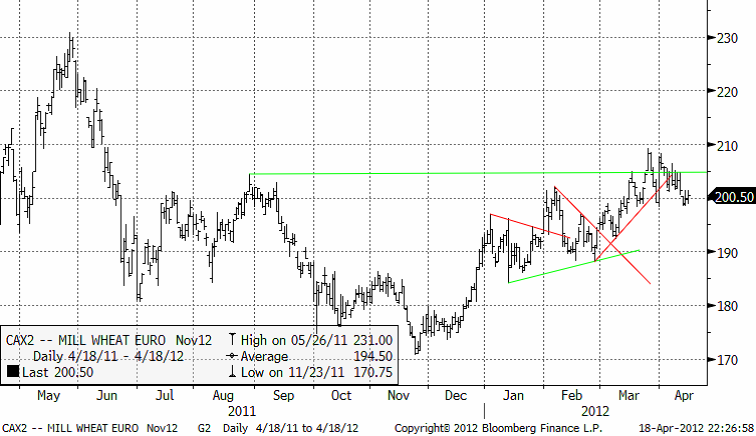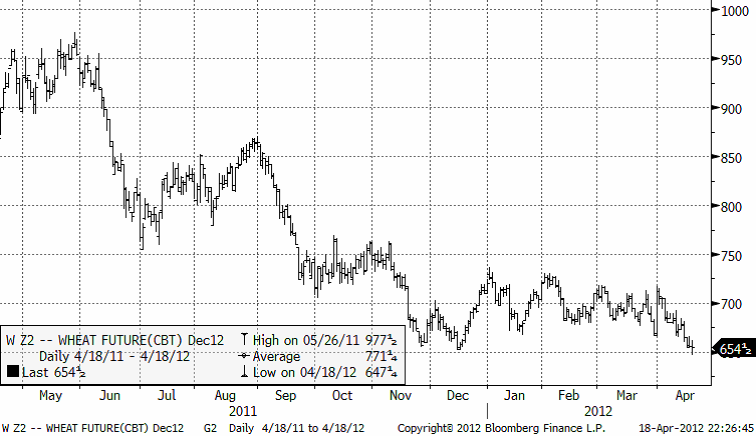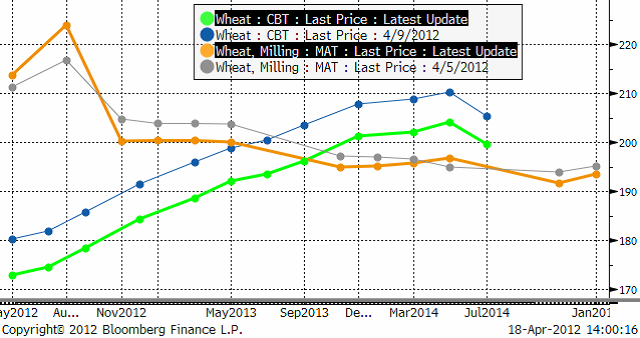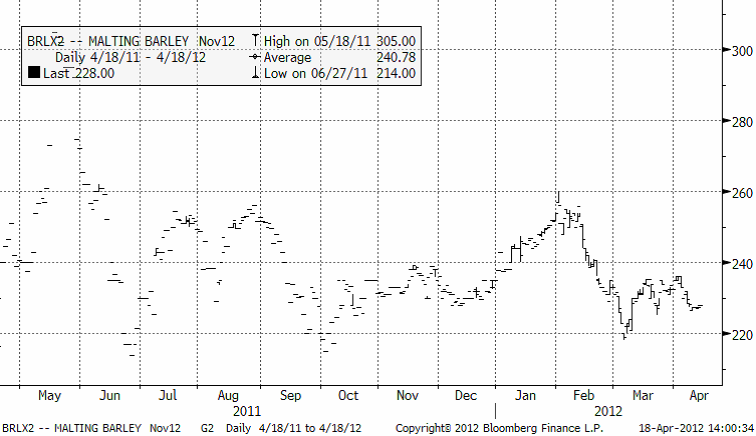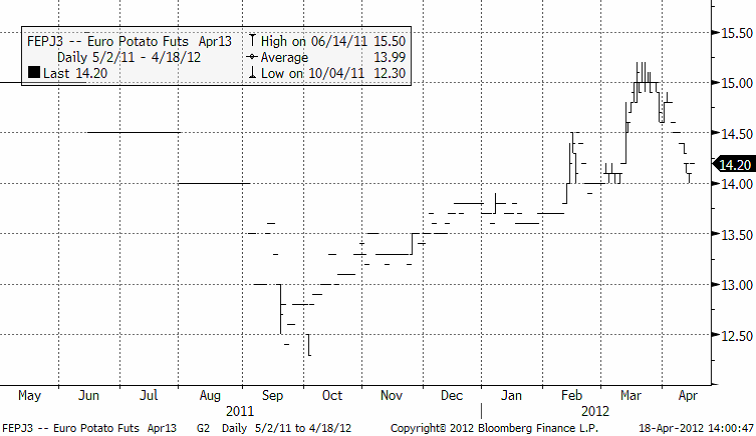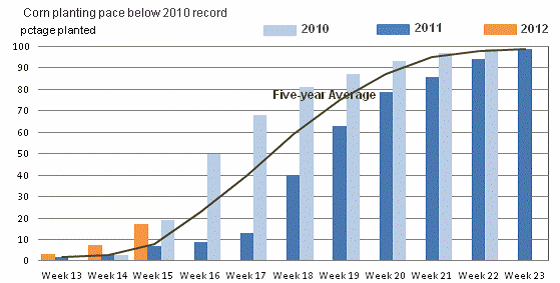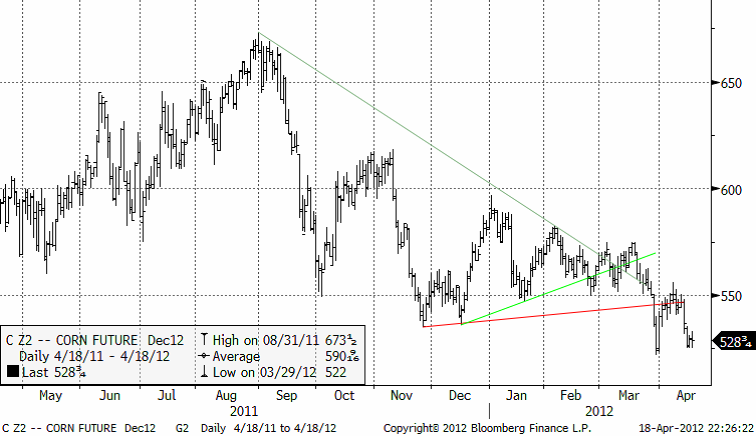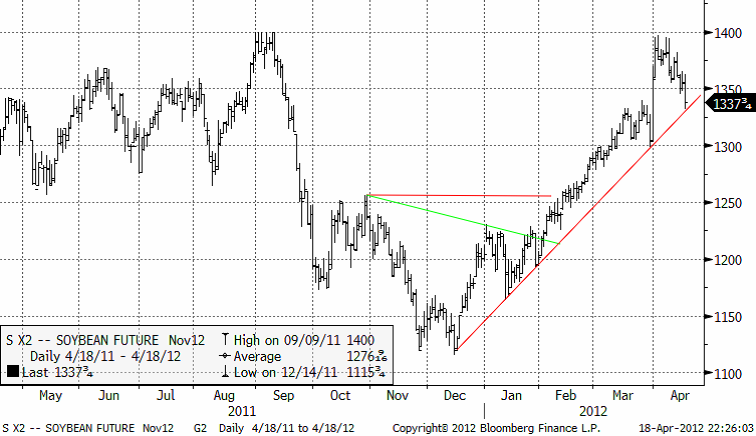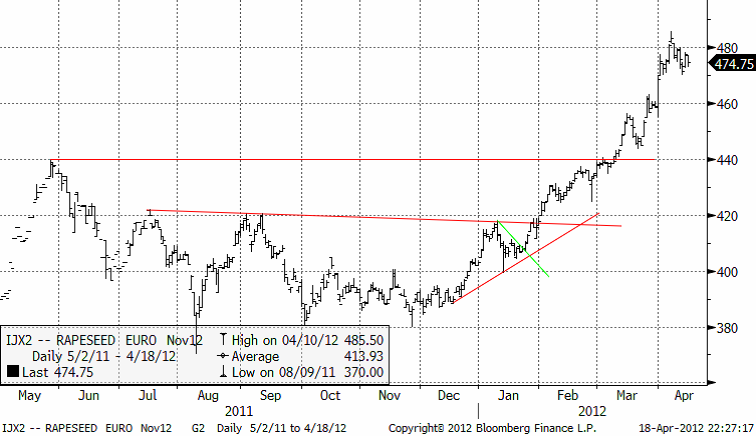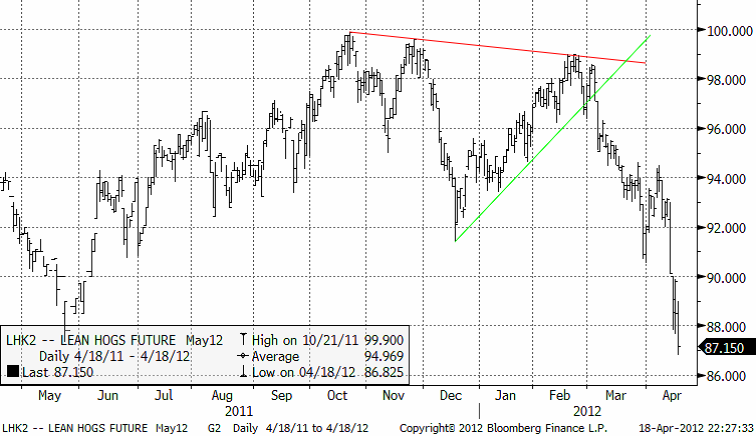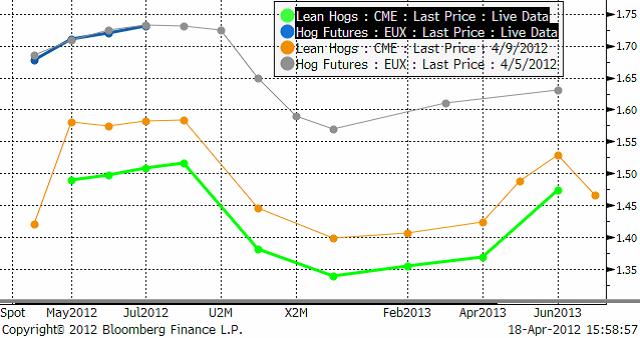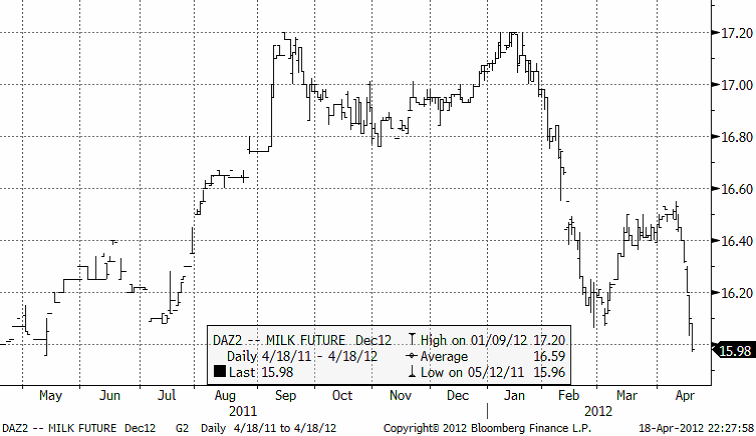Analys
SEB – Jordbruksprodukter, vecka 16 2012
 Priserna har generellt sett fallit på jordbruksprodukter sedan förra veckan. Största prisfallet noteras på europeiska industripotatis med -9% för gammal skörd (-3% för ny), på majs med -5% och på Chicagovete med -3%.
Priserna har generellt sett fallit på jordbruksprodukter sedan förra veckan. Största prisfallet noteras på europeiska industripotatis med -9% för gammal skörd (-3% för ny), på majs med -5% och på Chicagovete med -3%.
Fredagens BNP-statistik från Kina lade sordin på stämningen i början av veckan. Tillväxten blev 8.1% på årsbasis istället för 8.3% som marknadens förväntningar låg på. De senaste 30 åren har tillväxten i genomsnitt varit 9.9% per år. I tisdags släppte så IMF en tillväxtrapport som indikerade högre tillväxt, vilket gav tillbaka marknadens förtroende för råvaruefterfrågan. Sedan ökade oron för Spaniens ekonomi och därmed Europas hälsa och där står vi just nu.
Vi är glada att kunna meddela att CBOT startar handel i ”Black Sea Wheat Futures” den 6 juni 2012 och att vi därmed kan erbjuda våra kunder i dessa länder och kunder med exponering i Svarta havsområdet handel i futureskontrakt som är direkt kopplade till priserna på det fysiska vetet i regionen. Svarta havsvetet utgör mer än 20% av världshandeln av vete. Kontraktsstorleken blir 136 metriska ton, vilket ungefär motsvarar 5000 bushels. Skillnaden mot ”W”-kontraktet är att det här kontraktet är exakt 136 metriska ton, medan ”W” är exakt 5000 bushels. Leveranspunkterna är vid hamnar i Ryssland, Ukraina och i Rumänien. Kontraktet handlas elektroniskt på Globex från 9:00 till 18:15 svensk tid.
ICE Futures, som äger NYBOT (Kaffe, Kakao, Socker, Bomull) och börsen i Winnipeg, kommer att starta handel i majs, vete och sojabönor, förmodligen med bas i New York. Detta är i konkurrens med CBOT / CME Group. Vi tror inte att ICE kommer att vara framgångsrika i att attrahera likviditet. Likviditet attraherar mer likviditet och där vinner CBOT.
Odlingsväder
Det är mycket nära El Niño nu med ett Southern Oscillation Index (SOI) på -7.6. Nedan ser vi Southern Oscillation Index, som mäter ENSO och indikerar La Niña om SOI > +8 och El Niño om SOI < -8. Vi ser att SOI minskat från -4.1 förra veckan till -7.6 i dagens rapport. Det är den lägsta nivån sedan mars för två år sedan. El Niño är bra för skörden och La Niña är dåligt. Historiken säger att neutrala ENSO-förhållanden brukar följa efter att man haft La Niña i två år, men fallet i SOI är mycket kraftigt just nu, så vem vet?
NOAA kanske vet. Så vi tittar lite på deras senaste ensembleprognoser, publicerade den 16 april. CFS.v1 ligger något ”högre” den här veckan än förra veckan. Det vill säga, lite mer åt El Niño-hållet.
Nedan ser vi den andra modellen, CFS.v2, som också blivit mer åt El Niño-hållet.
Vete
Nederbörden har varit god såväl i USA som i Europa. Sådden i USA av vårvete går framåt i snabb takt. Det spanska jordbruksdepartementet rapporterade igår onsdag att skörden av vete totalt i landet väntas bli 22% lägre än förra året och landa på 5.36 mt. Kornskörden väntas falla med 28% från 8.33 mt förra året. Total spannmålsproduktion väntas falla med 25% till 12.7 mt. Orsaken är den extrema torka som drabbat landet. Perioden december till februari var den torraste sedan åtminstone 1947.
 Vädret har bättrat sig något, men nederbördsmängden i mars var den lägsta sedan 1997. Strategie Grains, motsätter sig idéerna på en ökad veteproduktion i Europa i år, till följd av köldknäppen i februari, även om andra analytikers farhågor över det senaste väderhotet, torka, har minskat. Strategie Grains som ursprungligen förutspådde att köldknäppen inte skulle orsaka alltför stora skador, har nu justerat ned sin prognos för EU:s kommande veteskörd – världens största – för andra gången, denna gång med 4.3 mt till 126.8 mt. Nedjusteringen tar också höjd för ett visst produktionsbortfall pga alltför torrt väder och bortfallet väntas drabba framförallt Frankrike och Tyskland.
Vädret har bättrat sig något, men nederbördsmängden i mars var den lägsta sedan 1997. Strategie Grains, motsätter sig idéerna på en ökad veteproduktion i Europa i år, till följd av köldknäppen i februari, även om andra analytikers farhågor över det senaste väderhotet, torka, har minskat. Strategie Grains som ursprungligen förutspådde att köldknäppen inte skulle orsaka alltför stora skador, har nu justerat ned sin prognos för EU:s kommande veteskörd – världens största – för andra gången, denna gång med 4.3 mt till 126.8 mt. Nedjusteringen tar också höjd för ett visst produktionsbortfall pga alltför torrt väder och bortfallet väntas drabba framförallt Frankrike och Tyskland.
FranceAgrimer estimerar 2011/12 års veteproduktion för Europas största veteproducent Frankrike till 33.9 mt, oförändrat från förra månadens estimat och en sänkning med 1.8 mt från 2010/11. Utgående lager för 2011/12 estimeras till 2.1 mt, en nedgång från tidigare estimat på 2.4 mt pga positiva exportutsikter.
Arealen för franskt vete kan komma att minska med 5.4 procent till 4.72 miljoner hektar från 4.98 miljoner hektar under 2011 säger FranceAgrimer, som förra månaden uppskattade att lantbrukare hade sått 5.07 miljoner hektar vete, en ökning med 1.7 procent jämfört med förra årets areal. Arealen justeras ned till följd av de skador som är förenade med utvintringen i landet och innebär att arealen för det ”mjuka” vetet i Frankrike skulle vara den lägsta sedan 2003, då franska bönder skördade 4.52 miljoner hektar av grödan och produktionen föll till 29.1 mt från 37.3 mt föregående år.
Estimatet för arealen i Lorraine, som förra året stod för 4.6 procent av produktionen, har justerats ned till 69 850 hektar från 253 000 hektar. Lantbrukare i Champagne-Ardennes, som stod för 9.3 procent av förra årets skörd, kommer att odla vete på 302800 hektar, jämfört med de 415 000 hektar som estimerades i mars.
Temperaturen i regionerna Lorraine, Champagne och Bourgogne sjönk så lågt som till minus 20 grader i februari, vilket har skadat grödorna. Av det franska vetet anses 62% vara i ”good to excellent condition” jämfört med 75% vid samma tid förra året.
Bulgariens veteskörd kommer sannolikt att bli lägre än förra årets skörd till följd av en torr höst och köldknäppar under vintern. Landet skördade 4.3 mt vete under 2011, av vilket en stor del exporteras, främst till Spanien. Även om inte jordbruksministeriet vill ge någon exakt prognos räknar lantbrukarna emellertid med en minskning på 20% av veteskörden till ca 3.4 mt i år pga försenad sådd och utvintring.
Rysslands spannmålsexport väntas uppgå till rekordhöga 26 mt den här säsongen enligt SovEcon, 1 mt lägre än förra månadens prognos, och med den siffran så skulle landet bli världens näst största exportör av vete efter USA. Om den exportprognosen, för nuvarande säsong som varar fram till den 30 juni, slår in kommer man att slå det förra rekordet på 23 mt som sattes 2008/09. Andra källor säger att exporten som mest kommer att uppgå till 20.5-21 mt. Logistiken är ett problem och framförallt bristen på järnvägsvagnar gör att de stora avstånden i transporten av spannmålen som finns längre in i landet till hamnarna medför höga transportkostnader. Ryssland räknar med att skörda ca 90 mt under 2012/13, ner från 94.2 mt under 2011/12. Skörden förväntas bli mindre på grund av det kalla vädret som har påverkat grödorna i landets stora spannmålsproducerande regioner i södra Ryssland.
Ukrainas jordbruksministerium estimerar landets spannmålsexport för nuvarande säsong (juli 2011 – juni 2012) i nivå med 23.5 mt, vilket skulle innebära att det finns utrymme för ytterligare export av 7 mt spannmål då landet till dags dato har exporterat ca 16.5 mt spannmål, en ökning med 4 mt jämfört med samma period förra året. Årets spannmålsskörd förväntas uppgå till 46.8 mt jämfört med rekord nivån på 56.7 mt förra säsongen. Vårsådden pågår nu för fullt och runt 62% är redan avklarat.
Ukraina kommer att bygga en ny spannmålsterminal i Odessa som tas i bruk i september 2013. Den ska hantera 15% av landets spannmålsexport. Kazakstan har justerat ned prognosen för landets spannmålsexport den här säsongen pga bristen på järnvägsvagnar, enligt jordbruksministeriet. Prognosen nu ligger på 11-12 mt mot tidigare 15 mt, eftersom man inte kommit upp i det tidigare beräknade snittet på 1.2 mt i månaden. Kazakstan, som rankas som en av världens 10 största exportörer av vete, har fått kämpa hårt med logistiken den här säsongen för att exportera sin rekordskörd på 27 mt. Långa avstånd till hamnar vid Svarta Havet och bristen på funktionsdugliga järnvägsvagnar har hämmat exporten. Mellan den 1 juli 2011, starten på nuvarande säsong, och den 1 april 2012 hade 8.4 mt spannmål exporterats och merparten går till traditionella marknader i Centralasien och Iran. Om dessutom Kazakstans lager av spannmål kvarstår på dessa höga nivåer kommer inte lagringsutrymmena att räcka till för kommande skörd. Enligt RusAgroTrans har Ryssland, Kazakstan och Ukraina exporterat 45.3 mt spannmål under perioden juli 2011 – mars 2012. Den totala spannmålsexporten för 2011/12 estimeras till 59.2 mt. (Prognos för 2011/12; Ryssland 25.7 mt, Ukraina 21 mt, Kazakstan 12.5 mt).
Tisdagens statistik från USDA visar att det amerikanska höstvetet per den 15 april till 64% klassas som ”good to excellent”, att jämföra med 61% veckan innan. För ett år sedan klassades 36% av höstvetet som ”good to excellent”.
Winter Wheat Condition – Week Ending April 15, 2012
Sådden av det amerikanska vårvetet är avklarad till 37%, vilket är rekordfort och väl över det 5-åriga genomsnittet på 9%. Det tidigare rekordet för sådd av vårvete i mitten på april sattes 1988, då lantbrukare hade sått 32% av grödan.
Lantbrukare i Argentina förbereder sig nu att påbörja sådden av 2012/13 års höstvete och arealen förväntas sjunka med ca 15% på årsbasis då låga globala priser gör att lantbrukarna föredrar att så andra grödor. Under säsongen 2011/12 såddes 4.6 miljoner hektar vete och en ytterligare minskning av arealen kommer att belysa övergången till andra grödor som lantbrukarna gör på grund av snäva exportbegränsningar som drar ner de lokala priserna. Argentina har traditionellt varit en ledande global exportör av vete, men har tappat marknadsandelar i takt med att lantbrukarna dragit ner odlingen. Regeringen Kirchner är inte bara impopulär i Spanien och Storbritannien, utan också bland landets egna bönder, som beskattas brutalt, t ex med en 36% skatt på export av sojabönor.
Under säsongen 2007/08, innan regeringen började driva igenom exportbegränsningar, odlade lantbrukarna vete på 5.9 miljoner hektar enligt jordbruksministeriet. Argentina producerade 13.4 mt vete under 2011/12, där huvuddelen av exporten går till grannlandet Brasilien. Mer om presidenten Cristina Fernandez de Kirchners bråk med lantbrukarna i Argentina finns att läsa på Bloomberg.
Luis Majul skrev en föga smickrande bok om Cristina Fernandez och hennes man Kirchner för två år sedan. En recension finns att läsa här.
Europas vintervete har påverkats av torka. Förra veckan visade vi kartbilden som visade graden av torka. I USA, som är det största exportlandet, och på många sätt därmed avgör priset på världsmarknaden, ser det bättre ut. Nedan ser vi priset på novemberterminen på Matif, där uppgången mot 210 brutits, men har stöd vid den jämna nivån 200 euro.
Nedan ser vi Chicagovetet med leverans i december. Ett tekniskt stöd tycks finnas på 650 cent. Bryts det, är det öppet för ytterligare fall.
Nedan ser vi hur terminspriserna på Matif och Chicago förändrats de senaste 7 handelsdagarna. Vi noterar två saker. Först att Chicagos priser fallit mycket mer än de europeiska. För det andra, att korta Matif-kontrakt faktiskt stigit. Och ska vi lägga till en ytterligare observation, så är det att priset skiljer mycket på spotmarknaden. Medan priset i Europa är 205 euro per ton, ligger det på 175 euro i USA, en mycket stor skillnad.
Men vi måste komma ihåg att det troligtvis ser som sämst ut just nu i Europa. Med La Niña borta och kanske ett El Niño på väg att bildas kan vädret bli mycket bättre. Skörden i Europa har påverkats väldigt lite av vädret under januari till mars och mycket mer av vädret under maj, juni och juli. Utsikterna för detta ser mycket bättre ut.
Maltkorn
Novemberkontraktet på maltkorn har inte rört sig mycket. Priset håller sig över 220 euro, en nivå som köpare tidigare tyckt varit ”för billigt”.
De torra väderförhållandena som väcker frågor kring Europas höstgrödor har gjort att odlare av maltkorn har kunnat så sin areal på dubbel så kort tid och därmed ökat chanserna för högre avkastning. Enligt RMI har lantbrukare i EU:s största maltkornsproducerande länder sått ca 93% i slutet av förra månaden. Tack vare de varma och torra förhållandena i februari och mars var sådden av maltkorn långt före schemat. Den här siffran, motsvarande sådd av drygt 3 miljoner hektar, jämförs med de ca 70% i slutet av mars förra året, vilket i sig var ett år med snabb sådd.
I själva verket är det den snabbaste sådden sedan RMI började med sina noteringar under 2003, medan det år då sådden gick som mest långsamt fram var 2006, då endast en tredjedel av sådden var avklarad vid den här tiden. Den snabba takten av sådden ger grödorna en ”bra chans” att utvidga sin ”naturliga växtperiod”, och därmed ge en ökad avkastning.
En bra maltkornsskörd skulle innebära en vändning från förra säsongen där regn, som drabbade de nordiska skördarna inklusive ledande producenten Danmark, ledde till kvalitetsproblem. Underskottet har bl a tvingat europeiska bryggerier att vända sig till Argentina. RMI klassar maltkornet i Storbritannien i ”utmärkt skick” i detta tidiga skede av säsongen efter att regn dragit in över torra områden i helgen och förväntas fortsätta under veckan. Överlag ser höstgrödorna väldigt bra ut och vårgrödorna, inklusive maltkorn har haft en utmärkt start i UK.
Vid sidan om detta säger HGCA, att det torra vädret inte påverkar grödornas tillväxt i detta skede, men regelbundna regn kommer att behövas för att upprätthålla avkastningspotentialen. Sådden av vårgrödor uppskattats att vara avklarad till 80%, jämfört med ett genomsnitt på 50% vid den här tiden i UK.
Arealen för korn i Frankrike beräknas sjunka med 12 procent till 924 315 hektar från tidigare 1,05 miljoner hektar under 2011 enligt FranceAgrimer. Tidigare estimat från dem visade istället på att arealen skulle stiga med 2.5 procent men justeras nu istället ned. 55% av höstkornet är i ”good to excellent condition” jämfört med 77% för ett år sedan och 76% av vårkornet är i ”good to excellent condition” jämfört med 87% förra året.
Potatis
Priset på industripotatis för leverans i år har fallit med 9%. För skörd nästa år har priset backat med 3%. Bättre (blötare) väder ligger sannolikt bakom, men potatisen kan vinna mark i spåren av krisen i Europa. Danmarks ”kartoffelkur” i minnet – i Grekland talas nu om samma sak – en potatiskur.
Majs
Sådden i USA väntas vara klar på rekordtid. Detta innebär att pollineringen kommer att inträffa tidigare än under den varmaste delen av sommaren. Detta brukar leda till en tidig skörd och en avkastning som ligger över trenden.
I USA har vädret i helgen gjort att sådden av amerikansk majs gått något långsammare, men tisdagens statistik ”crop progress” från USDA (som vanligtvis kommer på måndagar men som nu var försenad en dag pga en brand i USDA:s kontor i Washington) visar att lantbrukarna ligger långt före. Det varma vädret har värmt upp jorden. Per den 15 april hade 17% av arealen såtts, upp från 7% för en vecka sedan och långt över det femåriga snittet på 5%. Vid samma tid förra året låg siffran på 5%.
Corn seeding 17% complete
Årets majsareal i Kina beräknas öka med 2.7 procent från 2011 och därmed uppgå till 35 miljoner hektar, till följd av rekordhöga inhemska priser och subventioner. En rekordskörd av majs skulle kunna öka tillgången hos världens näst största konsument av grödan, vars tillväxt i produktionen inte har hängt med i den ökade efterfrågan under de senaste 3 åren och därmed gjort Kina till en nettoimportör av majs sedan 2009.
Utbudet av utsäde i delar av de nordöstra provinserna har börjat minska eftersom lantbrukare visare ett stort intresse för att så majs säger landets jordbruksministerium efter en undersökning gjord i 500 län.
Prisreaktionen i decemberkontraktet på CBOT var en prisnedgång, som vi ser i nedanstående kursdiagram. Vi skrev förra veckan att rekylen upp mot 550 var ett gyllene och klassiskt mönster att sälja på. Detta visade sig rätt. Nu testar marknaden bottennoteringen från slutet av förra månaden. Med stöd av vädret ”borde” priset falla vidare mot 500 cent.
Sojabönor
I Kina kommer arealen för sojabönor sannolikt att minska med 11.2% i år eftersom många lantbrukare i de nordöstra provinserna Heilongjiang och Inre Mongoliet förväntas odla majs istället för sojabönor. Arealen för vete förväntas vara oförändrad.
En lägre sojaproduktion i Kina, världens största importör av sojabönor, kommer att driva landets fortsatta import eftersom den inhemska sojan främst används till livsmedelsframställning, såsom tofu.
Nästan alla kinesiska ”crushers” är beroende av import av sojabönor för bearbetning av bönorna till sojamjöl, som efterfrågas som foderingrediens av djurindustrin. Utsikterna för Argentinas produktion av sojabönor fortsätter att dämpas på grund av torkan tidigare och enligt Buenos Aires Cereals Exchange kommer den att som mest uppgå till 44 mt, en nedjustering med 1 mt från deras tidigare prognos förra veckan. Det är en minskning med 10.5% på året. Rosario Grain Exchange sänker också sitt estimat för Argentinas produktion av sojabönor till 43.1 mt från 44.5 mt eftersom effekterna av torkan nu blivit tydliga, särskilt i de norra provinserna. Även OilWorld justerar ned sin prognos för produktionen av sojabönor i Argentina med 1 mt till 44 mt (med en fortsatt möjlig nedjustering till 42-42 mt). De justerar också ned prognosen för Brasiliens produktion med 500 000 ton till 65 mt pga torka.
Nedan ser vi kursdiagrammet på novemberkontraktet. Priset föll kraftigt under onsdagskvällen, ner mot stödlinjen. Trenden uppåt är dock intakt, men med tanke på hur hårt motståndet på 1400 cent verkar, förefaller det inte osannolikt att rekylen nedåt bryter genom stödlinjen. Den starka kraften i omslaget från La Niña till neutrala förhållanden eller rentav ett El Niño borde slå ut effekten av revideringarna av gamla estimat.
Raps
Den europeiska rapsproduktionen för 2012 förväntas minska med 3.3% till ett 5-års-lägsta efter att det kalla vädret har skadat grödorna i flera länder. Lantbrukare inom EU-27 förväntas skörda 18.48 mt raps i år, en nedgång från 19.1 mt året innan vilket är en kraftig nedjustering från OilWorlds tidigare estimat på 19.9 mt den 10 april.
EU odlar vanligtvis ungefär en tredjedel av världens rapsproduktion på 60 mt enligt statistik från USDA. Oljeväxten används till matolja, djurfoder och förädlas till biodiesel. OilWorld går så långt som att beskriva läget för rapsproduktionen som katastrofal för vissa delar av EU till följd av de dåliga förhållandena förra hösten då sådden av raps minskade och det torra vädret resulterade i dålig groning. Utöver det tillkommer också utvintring och svampangrepp. Alarmerande rapporter sägs ha kommit de senaste dagarna från Tyskland, Polen och Frankrike som visar på ett större bortfall än vad man tidigare har trott pga utvintring. Rapsproduktionen i Frankrike, EU:s största producent, kan med sannolikhet komma att minska till 5.2 mt från 5.35 mt under 2011. Det största bortfallet väntas i Östeuropa, där produktionen i Polen förväntas falla till 1.85 mt från 1.87 mt förra året. I Rumänien förväntas lantbrukare skörda 180 000 ton raps, mindre än en tredjedel av förra årets skörd på 670.000. ton och i Bulgarien kan produktionen komma att sjunka till 270 000 ton från 520 000 ton. Med torkan som drabbat Storbritannien efter den kalla vintern förväntas landets rapsproduktion att sjunka till 2.6 mt från tidigare 2.7 mt. I Tyskland däremot, där rapsfälten drabbades av torka förra våren, kan dock produktionen komma att öka till 4.45 mt från tidigare 3.8 mt.
I Kanada, förväntas lantbrukare öka sådden av canola med 500 000–1 miljon hektar från förra årets 7.6 miljoner hektar. StatsCanada kommer med sin rapport i nästa vecka över Canadian Planting Intentions där en rekordareal för canola förväntas, frågan är bara hur stor. Frontkontraktet för raps på Matif noterade ett 14-månaders högsta den 5 april då bl a farhågor över det kalla vädrets påverkan på den europeiska rapsproduktionen tillsammans med nedjusteringar av den sydamerikanska sojabönsproduktionen har gett stöd åt priset.
Nedan ser vi kursdiagrammet för novemberkontraktet, som gick upp över 480 euro per ton innan priset föll tillbaka och stängde på 474.75 euro igår, onsdag.
Gris
Majkontraktet faller handlöst och stängde under onsdagskvällen på nära dagslägsta.
Nedan ser vi terminspriserna på Eurex i euro per kilo och på CME omräknat till euro per kilo. Vi ser att priserna ligger mycket lägre i USA. Vi ser också att prisfallet i USA den senaste veckan inte alls inträffat i Tyskland. Tyskland ”borde” hänga med och en gissning är att det kommer att inträffa.
Mjölk
Mjölkpriset som steg successivt under förra året och gjorde en teknisk så kallad ”dubbeltopp” på 17:20 cent i decemberkontraktet, har sedan fallit kraftigt. Dubbeltopp är en klassisk toppformation. Det är svårt att säga var prisfallet ska stanna, men det ser ut att vara övertygade säljare i alla fall.
[box]SEB Veckobrev Jordbruksprodukter är producerat av SEB Merchant Banking och publiceras i samarbete och med tillstånd på Råvarumarknaden.se[/box]
Disclaimer
The information in this document has been compiled by SEB Merchant Banking, a division within Skandinaviska Enskilda Banken AB (publ) (“SEB”).
Opinions contained in this report represent the bank’s present opinion only and are subject to change without notice. All information contained in this report has been compiled in good faith from sources believed to be reliable. However, no representation or warranty, expressed or implied, is made with respect to the completeness or accuracy of its contents and the information is not to be relied upon as authoritative. Anyone considering taking actions based upon the content of this document is urged to base his or her investment decisions upon such investigations as he or she deems necessary. This document is being provided as information only, and no specific actions are being solicited as a result of it; to the extent permitted by law, no liability whatsoever is accepted for any direct or consequential loss arising from use of this document or its contents.
About SEB
SEB is a public company incorporated in Stockholm, Sweden, with limited liability. It is a participant at major Nordic and other European Regulated Markets and Multilateral Trading Facilities (as well as some non-European equivalent markets) for trading in financial instruments, such as markets operated by NASDAQ OMX, NYSE Euronext, London Stock Exchange, Deutsche Börse, Swiss Exchanges, Turquoise and Chi-X. SEB is authorized and regulated by Finansinspektionen in Sweden; it is authorized and subject to limited regulation by the Financial Services Authority for the conduct of designated investment business in the UK, and is subject to the provisions of relevant regulators in all other jurisdictions where SEB conducts operations. SEB Merchant Banking. All rights reserved.
Analys
Brent crude inching higher on optimism that US inflationary pressures are fading


Brent crude price inching higher on optimistic that US inflationary pressures are fading. Brent crude closed up 1.1 USD/b ydy to a close of USD 86.39/b which was the highest close since the end of April. This morning it is trading up another half percent to USD 86.9/b along with comparable gains in industrial metals and Asian equities. At 14:30 CET the US will publish its preferred inflation gauge, the PCE figure. Recent data showed softer US personal spending in Q1. Expectations are now high that the PCE inflation number for May will show fading inflationary pressures in the US economy thus lifting the probability for rate cuts later this year which of course is positive for the economy and markets in general and thus positive for oil demand and oil prices. Hopes are high for sure.
Brent crude is trading at the highest since the end of April
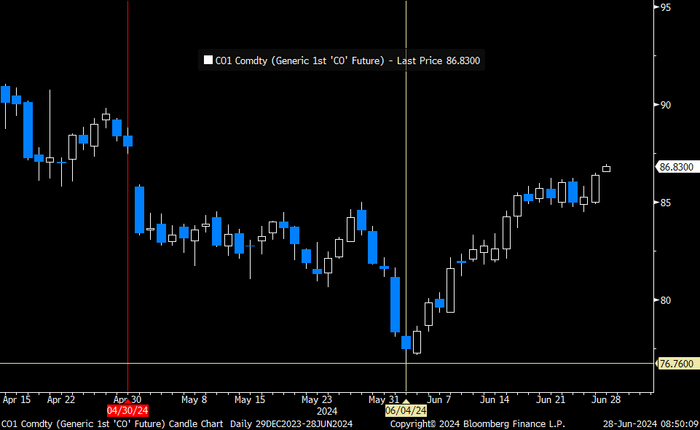
The rally in Brent crude since early June is counter to rising US oil inventories and as such a bit puzzling to the market.
US commercial crude and oil product stocks excluding SPR.
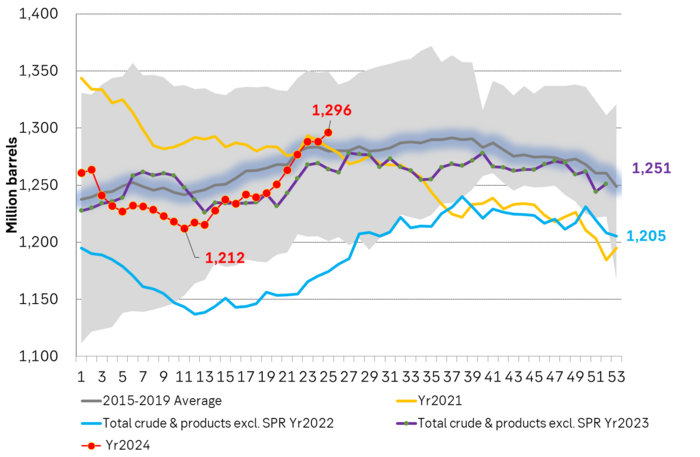
Actual US crude oil production data for April will be published later today. Zero growth in April is likely. Later today the US EIA will publish actual production data for US crude and liquids production for April. Estimates based on US DPR and DUC data indicates that there will indeed be zero growth in US crude oil production MoM in April. This will likely driving home the message that there is no growth in US crude oil production despite a Brent crude oil price of USD 83/b over the past 12 mths. The extension of this is of course rising expectations that there will be no growth in US crude oil production for the coming 12 months either as long as Brent crude hoovers around USD 85/b.
US production breaking a pattern since Jan 2014. No growth at USD 83/b. What stands out when graphing crude oil prices versus growth/decline in US crude oil production is that since January 2014 we have not seen a single month that US crude oil production is steady state or declining when the Brent crude oil price has been averaging USD 70.5/b or higher.
US Senate looking into the possibility that US shale oil producers are now colluding by holding back on investments, thus helping to keep prices leveled around USD 85/b.
Brent crude 12mth rolling average price vs 4mth/4mth change in US crude oil production. Scatter plot of data starting Jan 2014. Large red dot is if there is no change in US crude oil production from March to April. Orange dots are data since Jan 2023. The dot with ”-1.3%” is the March data point.
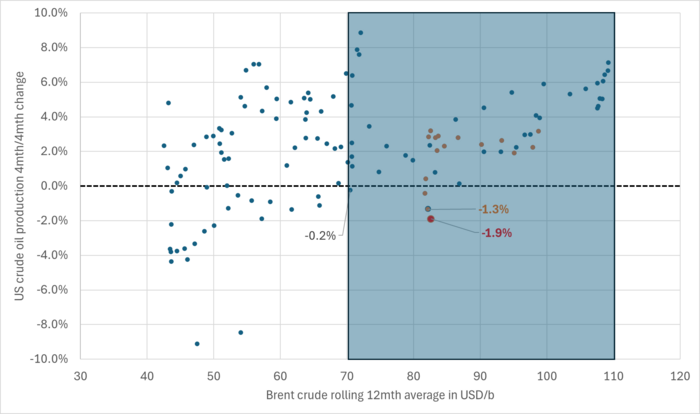
Brent crude 12mth rolling average price vs 4mth/4mth change in US crude oil production. Data starting Jan 2014. The last data point is if there is no change in US crude oil production from March to April.
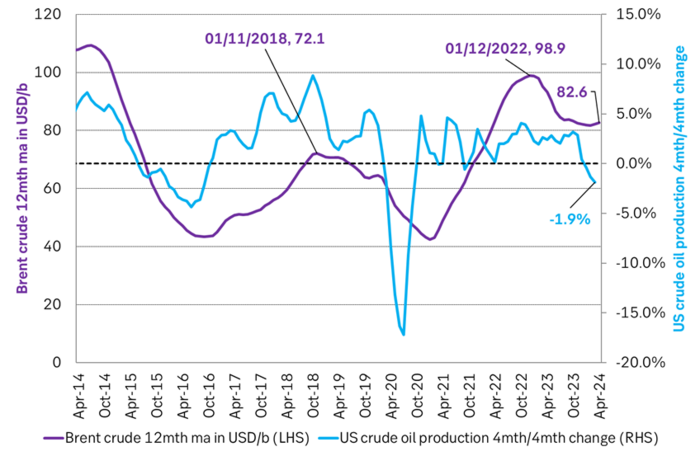
Analys
Price forecast update: Weaker green forces in the EU Parliament implies softer EUA prices


We reduce our forecast for EUA prices to 2030 by 10% to reflect the weakened green political agenda in the EU Parliament following the election for the Parliament on 6-9 June. The upcoming election in France on 7 July is an additional risk to the political stability of EU and thus in part also to the solidity of the blocks green agenda. Environmental targets for 2035 and 2040 are most at risk of being weakened on the margin. EUA prices for the coming years to 2030 relate to post-2030 EUA prices through the bankability mechanism. Lower post-2030 climate ambitions and lower post-2030 EUA prices thus have a bearish impact on EUA prices running up to 2030. Actual softening of post-2030 climate ambitions by the EU Parliament have yet to materialize. But when/if they do, a more specific analysis for the consequences for prices can be carried out.
EUA prices broke with its relationship with nat gas prices following the EU Parliament election. The EUA price has dutifully followed the TTF nat gas price higher since they both bottomed out on 23 Feb this year. The EUA front-month price bottomed out with a closing price of EUR 50.63/ton on 23 Feb. It then reached a recent peak of EUR 74.66/ton on 21 May as nat gas prices spiked. Strong relationship between EUA prices and nat gas prices all the way. Then came the EU Parliament election on 6-9 June. Since then the EUA price and TTF nat gas prices have started to depart. Bullish nat gas prices are no longer a simple predictor for bullish EUA prices.
The front-month EUA price vs the front-year TTF nat gas price. Hand in hand until the latest EU Parliament election. Then departing.
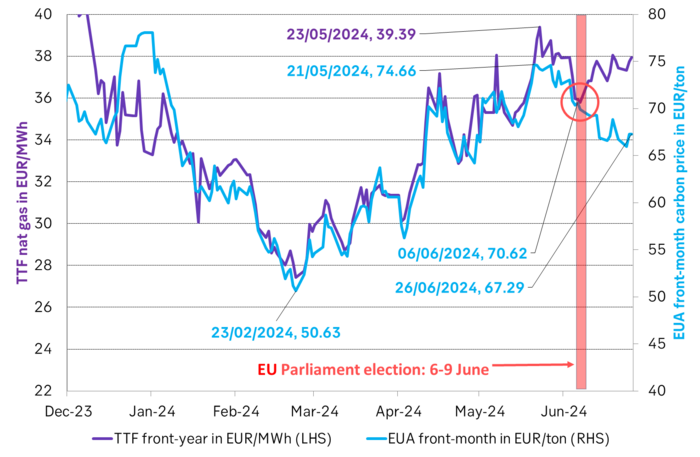
The EU Parliament election on 6-9 June was a big backlash for the Greens. The Greens experienced an euphoric victory in the 2019 election when they moved from 52 seats to 74 seats in the Parliament. Since then we have had an energy crisis with astronomic power and nat gas prices, rampant inflation and angry consumers being hurt by it all. In the recent election the Greens in the EU Parliament fell back to 53 seats. Close to where they were before 2019.
While green politics and CO2 prices may have gotten a lot of blame for the pain from energy prices over the latest 2-3 years, the explosion in nat gas prices are largely to blame. But German green policies to replace gas and oil heaters with heat pumps and new environmental regulations for EU farmers are also to blame for the recent pullback in green seats in the Parliament.
Green deal is still alive, but it may not be fully kicking any more. Existing Green laws may be hard to undo, but targets for 2035 and 2040 will be decided upon over the coming five years and will likely be weakened.
At heart the EU ETS system is a political system. As such the EUA price is a politically set price. It rests on the political consensus for environmental priorities on aggregate in EU.
The changes to the EU Parliament will likely weaken post-2030 environmental targets. The changes to the EU Parliament may not change the supply/demand balance for EUAs from now to 2030. But it will likely weaken post-2030 environmental targets and and thus projected EU ETS balances and EUA prices post-2030. And through the bankability mechanism this will necessarily impact EUA prices for the years from now to 2030.
Weaker post-2030 ambitions, targets and prices implies weaker EUA prices to 2030. EUA prices are ”bankable”. You can buy them today and hold on to them and sell them in 2030 or 2035. The value of an EUA today fundamentally rests on expected EUA prices for 2030/35. These again depends on EU green policies for the post 2030 period. Much of these policies will be ironed out and decided over the coming five years.
Weakening of post-2030 targets have yet to materialize. But just talking about it is a cold shower for EUAs. These likely coming weakenings in post-2030 environmental targets and how they will impact EUA prices post 2030 and thus EUA prices from now to 2030 are hard to quantify. But what is clear to say is that when politicians shift their priorities away from the environment and reduce their ambitions for environmental targets post-2030 it’s like a cold shower for EUA prices already today.
On top of this we now also have snap elections in the UK on 4 July and in France on 7 July with the latter having the potential to ”trigger the next euro crisis” according to Gideon Rachman in a recent article in FT.
What’s to be considered a fair outlook for EUA prices for the coming five years in this new political landscape with fundamentally changed political priorities remains to be settled. But that EUA price outlooks will be lowered versus previous forecasts is almost certain.
We reduce our EUA price forecast to 2030 by 10% to reflect the new political realities. To start with we reduce our EUA price outlook by 10% from 2025 to 2030 to reflect the weakened Green agenda in the EU parliament.
SEB’s EUA price forecast, BNEF price forecasts and current market prices in EUR/MWh
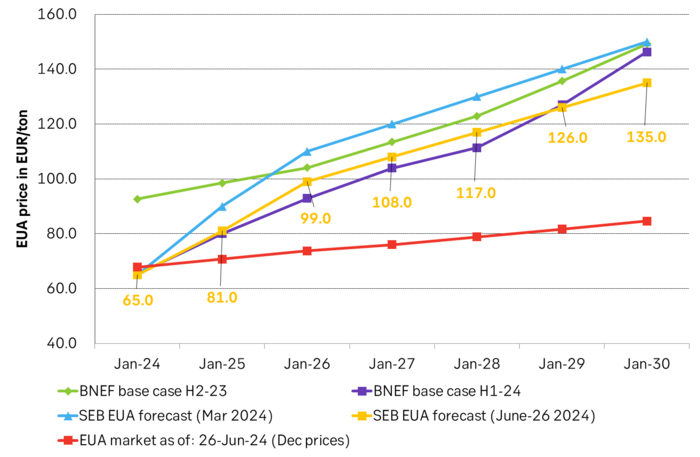
Analys
The most important data point in the global oil market will be published on Friday 28 June


US crude oil production has been booming for more than a decade. Interrupted by two setbacks in response to sharp price declines. The US boom has created large waves in the global oil market and made life very difficult for OPEC(+). Brent crude has not traded below USD 70/b since Dec-2021 and over the past year, it has averaged USD 84/b. US shale oil production would typically boom with such a price level historically. However, there has been zero growth in US crude oil production from Sep-2023 to Mar-2024. This may be partially due to a cold US winter, but something fundamentally seems to have changed. We recently visited a range of US E&P and oil services companies in Houston. The general view was that there would be zero growth in US crude oil production YoY to May 2025. If so and if it also is a general shift to sideways US crude oil production beyond that point, it will be a tremendous shift for the global oil market. It will massively improve the position of OPEC+. It will also sharply change our perception of the forever booming US shale oil supply. But ”the proof is in the pudding” and that is data. More specifically the US monthly, controlled oil production data is to be published on Friday 28 June.
The most important data point in the global oil market will be published on Friday 28 June. The US EIA will then publish its monthly revised and controlled oil production data for April. Following years of booming growth, the US crude oil production has now gone sideways from September 2023 to March 2024. Is this a temporary blip in the growth curve due to a hard and cold US winter or is it the early signs of a huge, fundamental shift where US crude oil production moves from a decade of booming growth to flat-lining horizontal production?
We recently visited a range of E&P and oil services companies in Houston. The general view there was that US crude oil production will be no higher in May 2025 than it is in May 2024. I.e. zero growth.
It may sound undramatic, but if it plays out it is a huge change for the global oil market. It will significantly strengthen the position of OPEC+ and its ability to steer the oil price to a suitable level of its choosing.
The data point on Friday will tell us more about whether the companies we met are correct in their assessment of non-growth in the coming 12 months or whether production growth will accelerate yet again following a slowdown during winter.
The US releases weekly estimates for its crude oil production but these are rough, temporary estimates. The market was fooled by these weekly numbers last year when the weekly numbers pointed to a steady production of around 12.2 m b/d from March to July while actual monthly data, with a substantial lag in publishing, showed that production was rising strongly.
The real data are the monthly, controlled data. These data will be the ”proof of the pudding” of whether US shale oil production now is about to shift from a decade of booming growth to instead flat-line sideways or whether it will drift gradually higher as projected by the US EIA in its latest Short-Term Energy Outlook.
US crude oil production given by weekly data and monthly data. Note that the monthly, controlled data comes with a significant lag. The market was thus navigating along the weekly data which showed ”sideways at 12.2 m b/d” for a significant period last year until actual data showed otherwise with a time-lag.
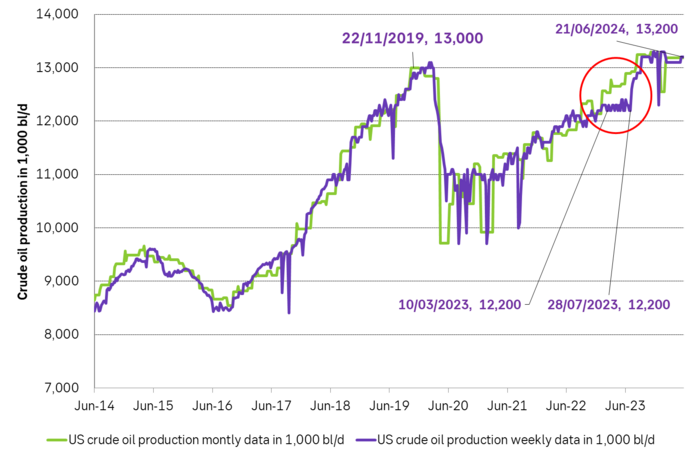
If we add in Natural Gas Liquids and zoom out to include history back to 2001 we see an almost uninterrupted boom in supply since Sep 2011 with a few setbacks. At first glance, this graph gives little support to a belief that US crude oil production now suddenly will go sideways. Simple extrapolation of the graph indicates growth, growth, growth.
US crude and liquids production has boomed since September 2011
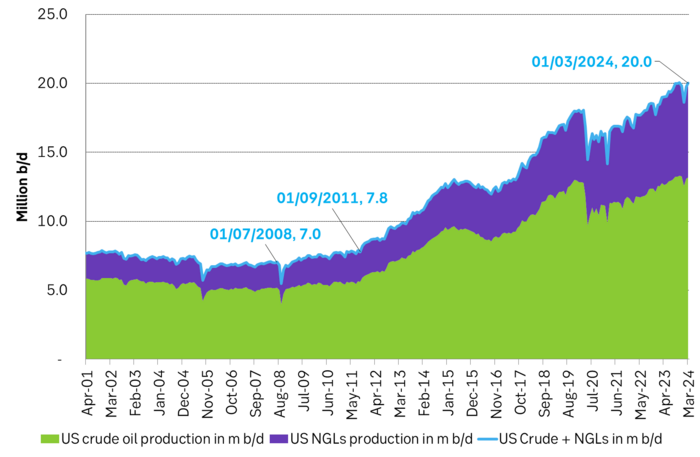
However. The latest actual data point for US crude oil production is for March with a reading of 13.18 m b/d. What stands out is that production then was still below the September level of 13.25 m b/d.
The world has gotten used to forever growing US crude oil production due to the US shale oil revolution, with shorter periods of sharp production declines as a result of sharp price declines.
But the Brent crude oil price hasn’t collapsed. Instead, it is trading solidly in the range of USD 70-80-90/b. The front-month Brent crude oil contract hasn’t closed below USD 70/b since December 2021.
Experiences from the last 15 years would imply wild production growth and activity in US shale oil production at current crude oil prices. But US crude oil production has now basically gone sideways to lower from September to March.
The big, big question is thus: Are we now witnessing the early innings of a big change in US shale oil production where we shift from booming growth to flat-lining of production?
If we zoom in we can see that US liquids production has flat-lined since September 2023. Is the flat-lining from Sep to Mar due to the cold winter so that we’ll see a revival into spring and summer or are we witnessing the early signs of a huge change in the global oil market where US crude oil production goes from booming growth to flat-line production.

The message from Houston was that there will be no growth in US crude oil production until May 2025. SEB recently visited oil and gas producers and services providers in Houston to take the pulse of the oil and gas business. Especially so the US shale oil and shale gas business. What we found was an unusually homogeneous view among the companies we met concerning both the state of the situation and the outlook. The sentiment was kind of peculiar. Everybody was making money and was kind of happy about that, but there was no enthusiasm as the growth and boom years were gone. The unanimous view was that US crude oil production would be no higher one year from now than it is today. I.e. flat-lining from here.
The arguments for flat-lining of US crude oil production here onward were many.
1) The shale oil business has ”grown up” and matured with a focus on profits rather than growth for the sake of growth.
2) Bankruptcies and M&As have consolidated the shale oil companies into larger, fewer public companies now accounting for up to 75% of total production. Investors in these companies have little interest/appetite for growth after having burned their fingers during a decade and a half of capital destruction. These investors may also be skeptical of the longevity of the US shale oil business. Better to fully utilize the current shale oil infrastructure steadily over the coming years and return profits to shareholders than to invest in yet more infrastructure capacity and growth.
3) The remaining 25% of shale oil producers which are in private hands have limited scope for growth as they lack pipeline capacity for bringing more crude oil from field to market. Associated nat gas production is also a problem/bottleneck as flaring is forbidden in many places and pipes to transport nat gas from field to market are limited.
4) The low-hanging fruits of volume productivity have been harvested. Drilling and fracking are now mostly running 24/7 and most new wells today are all ”long wells” of around 3 miles. So hard to shave off yet another day in terms of ”drilling yet faster” and the length of the wells has increasingly reached their natural optimal length.
5) The average ”rock quality” of wells drilled in the US in 2024 will be of slightly lower quality than in 2023 and 2025 will be slightly lower quality than 2024. That is not to say that the US, or more specifically the Permian basin, is quickly running out of shale oil resources. But this will be a slight headwind. There is also an increasing insight into the fact that US shale oil resources are indeed finite and that it is now time to harvest values over the coming 5-10 years. One company we met in Houston argued that US shale oil production would now move sideways for 6-7 years and then overall production decline would set in.
The US shale oil revolution can be divided into three main phases. Each phase is probably equally revolutionary as the other in terms of impact on the global oil market.
1) The boom phase. It started after 2008 but didn’t accelerate in force before the ”Arab Spring” erupted and drove the oil price to USD 110/b from 2011 to 2014. It was talked down time and time again, but it continued to boom and re-boom to the point that today it is almost impossible to envision that it won’t just continue to boom or at least grow forever.
2) The plateau phase. The low-hanging fruits of productivity growth have been harvested. The highest quality resources have been utilized. The halfway point of resources has been extracted. Consolidation, normalization, and maturity of the business has been reached. Production goes sideways.
3) The decline phase. Eventually, the resources will have been extracted to the point that production unavoidably starts to decline.
Moving from phase one to phase two may be almost as shocking for the oil market as the experience of phase 1. The discussions we had with oil producers and services companies in Houston may indicate that we may now be moving from phase one to phase two. That there will be zero shale oil production growth YoY in 2025 and that production then may go sideways for 6-7 years before phase three sets in.
US EIA June STEO report with EIA’s projection for US crude oil production to Dec-2025. Softer growth, but still growth.
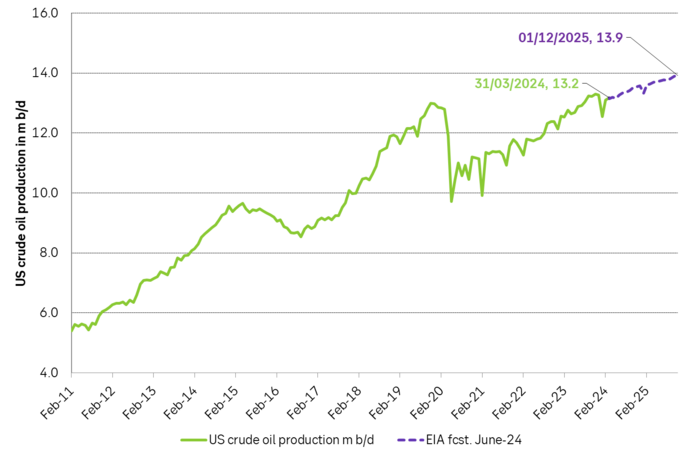
US EIA June STEO report with YoY outlook growth for 2025. Projects that US crude production will grow by 0.47 m b/d YoY in 2025 and that total liquids will grow by 720 k b/d YoY.
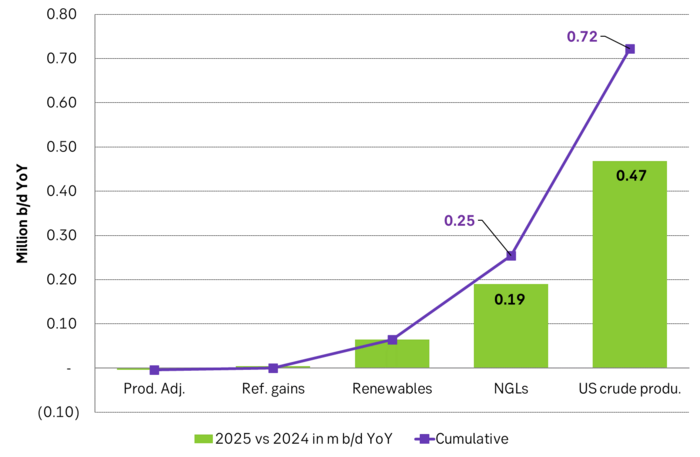
US EIA June STEO report with outlook for production growth by country in 2025. This shows how big the US production growth of 0.7 m b/d YoY really is compared to other producers around the world
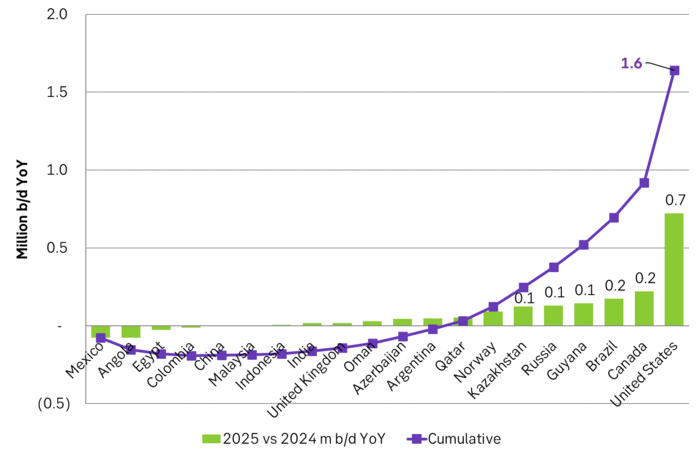
US EIA June STEO report with projected global growth in supply and demand YoY in 2025. Solid demand growth, but even strong supply growth with little room for OPEC+ to expand. Production growth by non-OPEC+ will basically cover global oil demand growth.
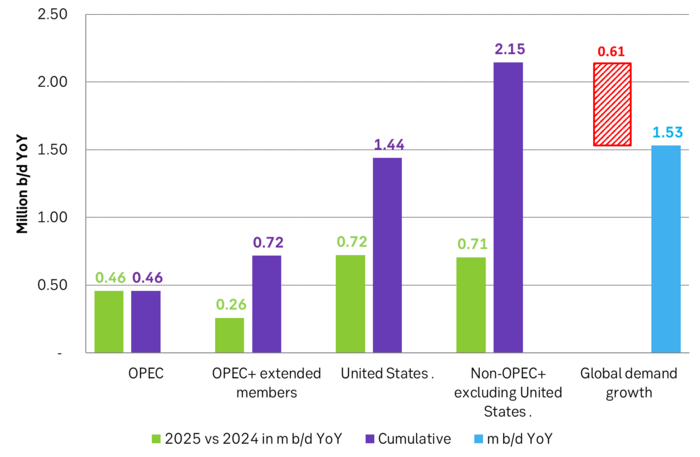
But if there instead is zero growth in US crude oil production in 2025 and the US liquids production only grows by 0.25 m b/d YoY due to NGLs and biofuels, then suddenly there is room for OPEC+ to put some of its current production cuts back into the market. Thus growth/no-growth in US shale oil production will be of huge importance for OPEC+ in 2025. If there is no growth in US shale oil then OPEC+ will have a much better position to control the oil price to where it wants it.
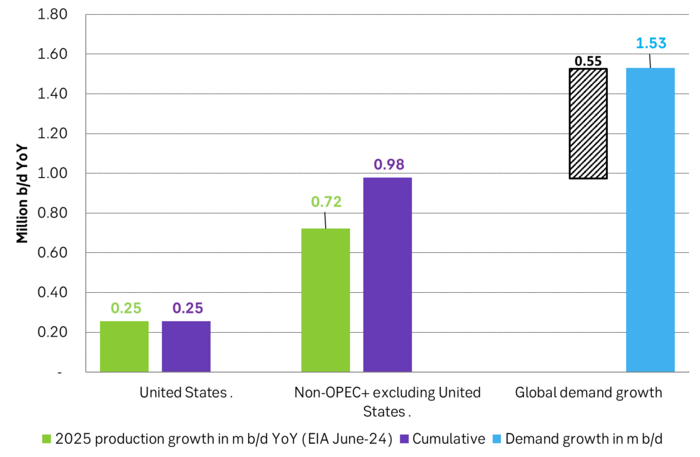
US crude oil production and drilling rig count
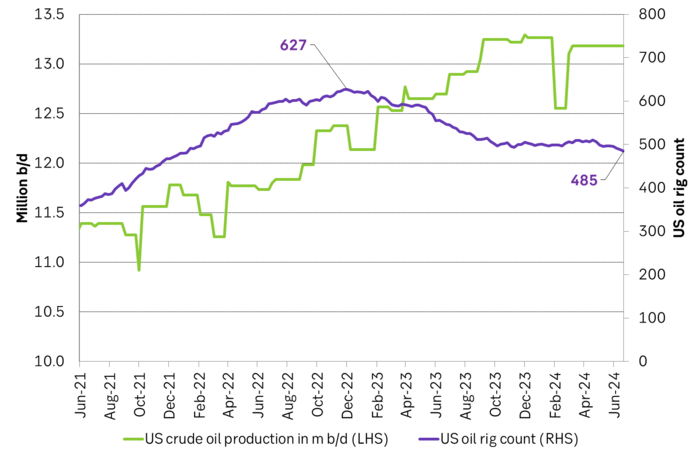
-

 Nyheter1 vecka sedan
Nyheter1 vecka sedanDe tre bästa råvaruvaruaktierna just nu
-

 Nyheter2 veckor sedan
Nyheter2 veckor sedanLundin Mining vill köpa Filo Corp tillsammans med BHP
-

 Nyheter4 veckor sedan
Nyheter4 veckor sedanAfrica Oil är bra att köpa anser Stifel som inleder analysbevakning
-
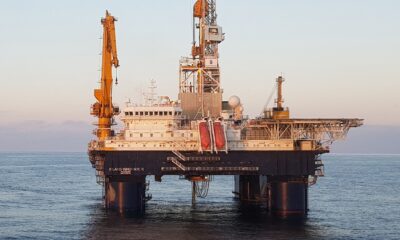
 Nyheter3 veckor sedan
Nyheter3 veckor sedanStor risk att Africa Energy inte överlever det kommande året
-
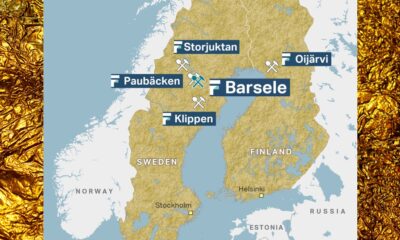
 Nyheter4 veckor sedan
Nyheter4 veckor sedanFirst Nordic Metals har fyra prospekteringsprojekt i Sverige
-

 Analys4 veckor sedan
Analys4 veckor sedanBrent crude inching higher on optimism that US inflationary pressures are fading
-

 Nyheter2 veckor sedan
Nyheter2 veckor sedanUniper satsar på att göra elektrobränsle av sin elektricitet
-

 Nyheter2 veckor sedan
Nyheter2 veckor sedanTre bra aktier inom olja och oljeservice i Kanada


